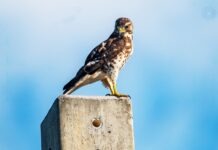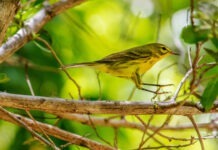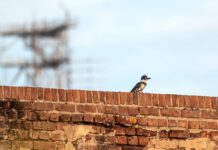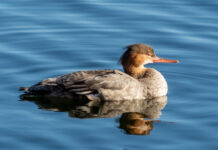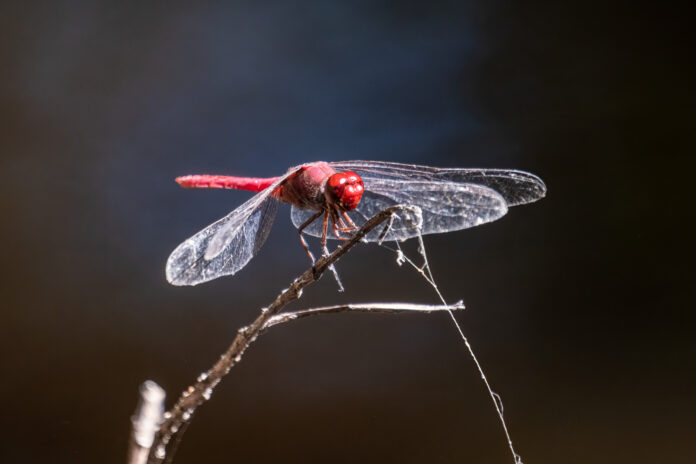
Sometimes it can feel as if you’re starting over again. For instance, I’ve never thought much about dragonflies, though I’ve always liked them and the hovering, near-linear way they move around the world.
It’s not like I know nothing about dragonflies. I know they and their closest relatives, the damselflies, are part of the order odonata, which biophiles usually just call odes. And I knew that a damselfly, when it lands, will hold its wings straight up, or fold them next to its body. And a dragonfly, when it lands, will just lay its wings flat and sticking out, like a set of temporarily unused oars. But I’d never gotten much further than that.
My curiosity has always been an unmarshallable force. I can’t tell it what to be interested in. It tells me.
But sitting on a bench by the muddy little puddle pond in the back corner at the Key West Tropical Forest & Botanical Garden the other day, my curiosity perked up a bit when a dragonfly came in and landed on a stalk.
It was red from tip to tail, a shiny deep carmine that gleamed metallic in the sun. The part of my brain that didn’t know better thought it might be a tiny little robot. Its four wings looked like minuscule stained glass windows if they’d been made out of clear, unstained glass.
Something sparked, and I thought, Huh, I wonder what that thing is called?
It was a familiar feeling, though not recently familiar. This is kind of how I came to birds. One day, I just thought, Birds, what the heck? And I started thinking about them. I started paying attention, I started building a framework of understanding.
I didn’t know how far I was going to run down Dragonfly Road, but I knew I had to at least gain some understanding of what I saw.
The first step is always putting a name to what you see. So I took a bunch of photos to try and figure it out when I got home.
There are a lot of fun facts about dragonflies. Like birds, the males tend to be the brightly colored ones. They are generally found near water. They often mate on the wing. Males have two sets of genitals, females one. Females can lay up to 1,500 eggs. Eggs take 7 to 8 days to hatch, but have also been known to take up to 360 days. Between the egg stage and the adult stage, they are flightless aquatic things called naiads (also called larvae or nymphs). In that stage they will shed their exoskeletons up to 17 times before they’re ready to take wing. Adults can live up to 10 weeks, but most species live about five. Some dragonflies species migrate, some don’t. Some species migrate so far that it takes multiple generations to complete the journey. Dragonflies existed before dinosaurs.
But none of these fun facts got me closer to being able to name that red dragonfly’s species.
There are about 3,000 species of dragonflies in the world, and about 330 in North America, about 100 of which occur in Florida. Which is a lot to choose from. I do own one dragonfly field guide – the Stoke’s Beginner’s Guide to Dragonflies – and there was one species in there called the roseate skimmer that looked kind of, sort of, like the dragonfly I saw, and which occurred in Florida. But it didn’t look quite right. The photo made it look more on the coral end of red spectrum than the scarlet end. So I did some Googling.
One of the things I found was a 2007 blog post from a man named Ed Lam who was writing a field guide to North American dragonflies, and who came to the Florida Keys to see some hard-to-find specimens. And one of the photos in the post rang the bell – it was the same type of dragonfly I saw at the Key West Botanical Garden. It was an Antillean skimmer, a species generally found in the Caribbean and at its edges. Stock Island is one of the few places in North America to reliably find them. Ah, I thought, itch scratched. When I looked at the Latin name, though, it seems the itch was only partly scratched. The Antillean skimmer was listed as Orthemis sp., the “sp.” part being how you describe a species when you’re not quite sure where it fits in the taxonomy, or when it is not officially considered a species. Since the blog entry was from 2007, I figured this taxonomic homelessness would have been worked out by now. But digging deeper, and reading what I could find in more recent literature, it seemed the Antillean skimmer is still not fully placed in the taxonomic tree. (In biological parlance, when a species doesn’t have official status, it is called “undescribed.”)
One of the names that kept popping up in what I read about dragonflies was Dennis Paulson, who seemed to be the dean of North American dragonflies. He’d written multiple field guides and numerous scientific papers about them.
He looked to be retired, but I sent an email off to the Slater Museum of Natural History in Oregon, where he’d been director for 15 years, asking for contact information, or for them to forward my email to him. My question? Why was the species still undescribed? I didn’t really expect to hear back, but the next morning I had an email from him. Paulson said that essentially, several decades back, an odontologist named Thomas Donnelly had looked at the roseate skimmer and decided it was really two species, one that was purple-ish, and one that was red, which was the Antillean skimmer. Most odontologists agreed with that, and later genetic testing backed it up.
“Unfortunately, Donnelly never described either of them, and he is now retired and probably won’t be writing anything more about dragonflies. No one else has picked up on it, and I don’t know who if anyone will. There has been a shocking decline in dragonfly researchers in this country, at the same time as a tremendous increase in amateur dragonfly enthusiasts. But universities aren’t training taxonomists or organismal biologists much anymore, so there are few people to take the place of the retirees,” wrote Paulson.
So I’m starting this whole dragonfly thing with a species that is distinct, but not officially a species, and may never be. It makes it hard to tick off a list, which is fine. I never keep lists anyhow. And I like a complicated backstory.




















